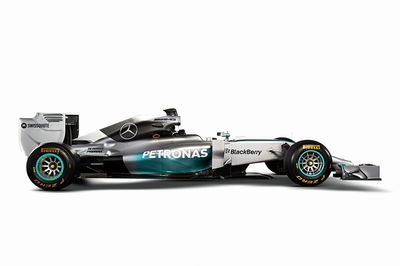Fluid technology solutions for F1

Since the modern era of the Silver Arrows began in 2010, Petronas has been the 'fluid technology solutions partner' of the Mercedes AMG P Petronas Formula One Team, maximising the potential of lubricant and fuel technology to provide differentiated performance.
For 2014, this relationship has been significantly enhanced, with Petronas and the Mercedes-Benz teams in Brackley and Brixworth working hand in hand to develop a high-performance racing machine within the new parameters of FIA regulations. If the Power Unit is the heart of the new Silver Arrow, its lifeblood is the tailor-made fuel and lubricant developed by Petronas ' technology.
This year, fuel energy density has become one of the controlling performance parameters for the sport and improving efficiency is now fully aligned with improving performance. In this context, lubricants and fuels have a crucial role to play in a number of different ways.
Petronas technologists have applied their expertise, honed through optimising Petronas Syntium for turbo-charged, direct fuel injection engines in everyday cars, to design and co-develop new lubricants to meet the new challenges posed by the Power Unit.
A key challenge is the downsizing of the F1 engines from V8, 2.4 litre engines to V6, 1.6 litre engines. The smaller Internal Combustion Engine (ICE) and increased power per litre mean that the new engine runs hotter. Oil thins at higher temperatures and thus a hotter engine needs a thicker oil to stop metal components from rubbing together and failing.
However, the hotter conditions and reduced quantity of oil in the ICE (reduced from almost seven litres for the V8 to fewer than three litres for the V6) also mean that the oil must contribute more to cooling the engine. This requires thinner, faster flowing oil.
Additionally, the regulation changes restrict the quantity of fuel that can be consumed per race to 100 kg, which means that the oil needs to help conserve energy by minimising friction. Again, this requires thinner oil.
In order to meet these complex and contradicting requirements, the new engine oil for the 2014 car is a precisely balanced mixture of advanced, thinner synthetic base oils to help cooling and polymer viscosity boosters (which kick-in at higher temperatures) to thicken the oil. Friction-reducing oil components, which make it easier for metal surfaces to slide past each other, have also been used to improve overall fuel economy.
Another consideration is that the higher temperatures also make it more likely that the oil itself will stop working properly. High performance additives have been included to stop the oil from breaking down under these extreme conditions.
Energy losses in the gearbox can also have a significant impact on fuel economy. To address this, Petronas technologists have also produced precision gearbox lubricants for the 2014 car to ensure that energy losses in the transmission are kept to a minimum, whilst making sure that the gearbox is protected from failure.
With regard to fuel, a direct injection turbocharged ICE has special requirements in terms of fuel characteristics, for example it is very important that the injector nozzles are not blocked by deposits that come from the fuel.
On top of that, the limits set by FIA with regard to maximum fuel quantity allowed (100 kg) and flow rate (100 kg/hour) mean that every single component in the fuel has to contribute to performance. Petronas scientists have developed a new fuel for the 2014 Power Unit molecule-by-molecule, balancing characteristics such as energy density, octane number and volatility with careful consideration of the mandatory fraction of the fuel that must be of bio-origin.
This poses a unique challenge in itself as some of the best components for delivering high, smooth power are also those that likely lead to deposit build-up in injector nozzles. An extensive development programme involving chemists and engineers testing new fuels in real engines has resulted in a new generation fuel for the V6 that promises to deliver a significant gain in performance.
The contribution of Petronas in delivering total fluid technology solutions has been essential to the delivery of the 2014 Power Unit. Never before in the history of F1 have a Power Unit and its lifeblood been developed so closely. In meeting a challenge almost diametrically opposed to that of the V8 engine, the Petronas technical partnership will be an integral factor in success.











